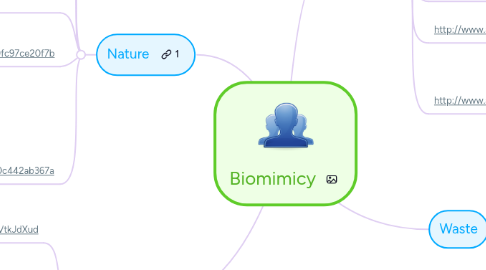
1. Nature
1.1. Action Point 1
1.2. Action Point 2
1.3. http://www.asknature.org/product/107c8e637bde3ccd25f19fc97ce20f7b
1.4. "Nature has already solved the riddle of enabling biological material stability at regular temperatures. Stabilitech's technology adapts some of nature's techniques using biomimicry. We have identified the underlying principle and components ne...
1.5. http://www.asknature.org/product/107c8e637bde3ccd25f19fc97ce20f7b
1.5.1. Each Poo-Gloo device is six feet in diameter, three feet high, and sits on a foot-tall base. Seven smaller plastic domes sit within this structure. They are lined with biofilm, and host heterotrophic and autotrophic bacteria that process the wastewater. Circulatory tubing moves wastewater and air over the microbial community at optimized intervals. These devices are additions to wastewater systems that must become compliant with stricter standards.
1.6. http://www.asknature.org/product/256b9f497821497773d9f0c442ab367a
1.6.1. As many ground plants vie for coveted food sources, ivy has found a niche that allows it to get enough sunlight and nutrients without having to compete with its fellow ground plants. By growing vertically using another structure for support, ivy receives direct sunlight without having to compete with other plants. SMIT is working to take advantage of this very unique niche as well with the Solar Ivy system. Perhaps of more interest from a biomimetic standpoint is the story of how SMIT is following many of Life's Principles in how it makes, uses, and deals with end-of-life issues of their product. The entire life cycle of the design is based on principles in nature, and through the creative use of existing alternative energy technologies and the intentional incorporation of sustainable design ethic, Solar Ivy has the potential to be one of the most sustainable solar and wind energy technologies on the market.
2. Humans
2.1. http://www.asknature.org/strategy/4190fb7f0d16994ddd143b1fd8dbc049#.UwYVtkJdXud
2.1.1. "Muscle fibers contain comblike arrays of filaments made from chains of the protein actin, with nodes of the myosin protein interdigitated between the combs' teeth. The ends of the filaments are covered with molecular 'motors' that can walk along actin filaments. When this motion is triggered by a nerve signal, the myosin rods become more deeply interdigitated, causing the muscle fiber to shorten." (Courtesy of the Biomimicry Guild)
2.2. http://www.asknature.org/strategy/89ac79ae89b423faee1f79d96ce5d6f1#.UwYWrEJdXuc
2.2.1. "The vertebrate integument represents an evolutionary compromise between the needs for mechanical protection and those of sensing the environment and regulating the exchange of materials and energy. Fibrous keratins evolved as a means of strengthening the integument while simultaneously providing a structural support for lipids, which comprise the principal barrier to cutaneous water efflux in terrestrial taxa…How do the structural features of keratin influence its resistance to water movement? Generally, structural features that alter the free volume (equivalent to pores or channels) should alter the permeation of water molecules accordingly. Resistance to diffusion is affected by the molecular mass of side chains and tends to increase with cross-linking beyond certain critical levels (Lieberman et al., 1972)…The stability of cross-linkages is dependent on a large number of intermolecular forces, including covalent, ionic, and hydrogen bonding in addition to van der Waals attractive forces between non-polar amino acid side chains. All of these act to influence the mobility and free volumes of the structure…Studies of human skin have indeed demonstrated that gradients of water exist in the stratum corneum (Warner et al., 1988; Bommannan et al., 1990; Caspers et al., 2001; Bouwstra et al., 2003a). Fourier transform infrared spectroscopy has demonstrated that free water content in stratum corneum is greater in central regions relative to superficial and deeper cell layers at moderate levels of hydration (57%–87%, w/w), whereas at higher levels of hydration (300% w/w) water swells corneocytes in a direction perpendicular to the skin surface except for the deepest cell layers adjacent to the viable epidermis (Bouwstra et al., 2003a). While the mechanism excluding free water from the deeper cell layers of stratum corneum is not understood, it is speculated to play a role in preventing dehydration of the viable epidermis. In relatively dry conditions (18%–26% w/w), only bound water is present in the stratum corneum (Bulgin and Vinson, 1967; Hansen and Yellin, 1972; Bouwstra et al., 2003a)." (Lillywhite 2006:202, 212, 213)
3. Product
3.1. Goals
3.1.1. Goal 1
3.1.2. Goal 2
3.2. Rules
3.2.1. Session Rule 1
3.2.2. Session Rule 2
3.2.3. Session Rule 2
3.3. Define Problems
3.4. Capture Ideas
3.5. Prioritize Ideas
3.6. Prioritize Ideas
3.7. Define Action Points
3.8. http://www.asknature.org/product/107c8e637bde3ccd25f19fc97ce20f7b
3.8.1. Vaccines are being involved from plants in the nature and this could be a big discover for us to stop some diseases.
3.9. http://www.asknature.org/product/256b9f497821497773d9f0c442ab367a
3.9.1. Perhaps of more interest from a biomimetic standpoint is the story of how SMIT is following many of Life's Principles in how it makes, uses, and deals with end-of-life issues of their product. The entire life cycle of the design is based on principles in nature, and through the creative use of existing alternative energy technologies and the intentional incorporation of sustainable design ethic, Solar Ivy has the potential to be one of the most sustainable solar and wind energy technologies on the market.
4. Waste
4.1. Problem 1
4.2. Problem 2
4.3. http://www.asknature.org/strategy/2bad51df7f545eb2acca674c89c2dd3b#.Uw0tCfRdXuc
4.3.1. "The ability to adapt in response to changes in functional demands sets living tissues apart from their engineered counterparts. Muscles grow during development, they remodel in response to use and disuse, and they are able to repair themselves after an injury…The modular design of muscle also facilitates the remodeling and repair of the muscle. The selfhealing properties of muscle emerge from the integration of muscles into a system that allows wound healing and continuous turnover via transport of nutrients and removal of waste products. It is arguably much simpler to grow and repair individual units than having to adapt the entire structure.
4.4. http://www.asknature.org/strategy/30ce62615f02629c0031dfd70a6c898f#.Uw0u7fRdXuc
4.4.1. The variety of substances that fungi can digest is extraordinary. Some can live on petroleum, others on the thin films that coat lenses. Silica, magnesium, iron, even plastic are all consumed by one kind or another.

